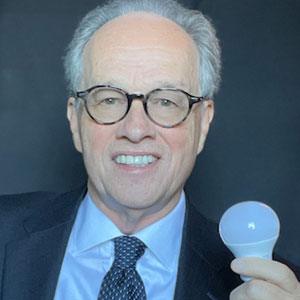Individual perception colors assessment of our industry
By Mark Lien
“It’s Mr. Doom & Gloom,” a voice shouted to me across a crowded room. It was a business dinner the night before my presentation to this group. The VP who yelled this had seen me at a previous event years earlier and apparently perceived my message as dystopian. The room quieted and it felt like everyone was watching. I asked him if I had said anything that was not accurate, and he said no. The still room expanded back into crowd noise.
Witnessing disparate reactions to the same message used to surprise me until a colleague once shared a relevant story. He said that someone new to town stopped at a gas station and asked an employee what the local people were like. The employee paused, then inquired as to how they were in the town he had just moved from. “Terrible, neighbors were not friendly and no one seemed happy,” said the person new to town. “I think you will find them the same here,” was the employee’s response. Shortly afterward, another new resident asked the same question. The employee again inquired about how people were in the town he came from. “Great,” he said. “We hated to leave, as they were so nice and caring.” The employee repeated his prediction, “I think you will find them the same here.”
 We all evolve from personal experiences that inform built-in filters and bias. Threats still loom large over our lighting community but my disposition is optimistic. The disruption we’re experiencing offers unprecedented opportunities that ultimately eclipse potential negative scenarios. To paraphrase author Peter Diamandis, we will generate more wealth in the next 10 years than the previous 100. There is easier access now to funding, education and expertise, and to advanced technologies than ever before. The cost of food, transportation, communications and energy has fallen dramatically over the past century. This abundance provides reason for optimism.
We all evolve from personal experiences that inform built-in filters and bias. Threats still loom large over our lighting community but my disposition is optimistic. The disruption we’re experiencing offers unprecedented opportunities that ultimately eclipse potential negative scenarios. To paraphrase author Peter Diamandis, we will generate more wealth in the next 10 years than the previous 100. There is easier access now to funding, education and expertise, and to advanced technologies than ever before. The cost of food, transportation, communications and energy has fallen dramatically over the past century. This abundance provides reason for optimism.
ON THE OTHER HAND
Still, impending threats are undeniable and ominous. Hacking vulnerabilities and ethical data-collection concerns, rising kWh rates as we shift to renewables, telecoms, electronics and Internet companies usurping our lighting community as we transition to IoT, production and regulatory advantages in Asia, closer corporate collaboration in Europe due to weaker antitrust legislation and other disruptive change can trigger thoughts of doom and gloom.
In a recent article from McKinsey & Company titled “Navigating the Digital Future: The Disruption of Capital Projects,” the authors wrote: “Productivity in the construction sector has stagnated for decades, with the average capital project reaching completion 20 months behind schedule and 80 percent over budget. Some overruns result from increased project complexity and scale, but another factor also looms large: all stakeholders in the capital-projects ecosystem—project owners, contractors, and subcontractors—have resisted adopting digital tools and platforms.” The article argued that “companies that want to emerge as leaders must transform their organizations now.” There is a threat from not rapidly embracing new technologies and an opportunity for “the first movers” to gain a strong competitive advantage. A common thread of the threats is that they become opportunities to those who accelerate the velocity of change and accept the accompanying heightened risk.
Ray Molony, publisher of Lux magazine, wrote on luxreview.com that “I (kinda) hate the lighting industry sometimes,” explaining that he is “regularly floored by the levels of dismissal and conservatism I hear in what is supposed to be a technical, innovative community.” I share Ray’s frustration. My experience is that some of the most innovative people in our community are not encouraged or empowered to pursue blue-sky endeavors let alone massively transformational purposes. They are dismissed by risk-averse decision makers who conservatively prefer low-risk (at least for the short term) incremental advancements. The departure of frustrated innovators from large corporations accelerates lighting start-ups and accounts for, in part, how many new and innovative small lighting companies have appeared in recent years. If that gas station employee asked me about the lighting community I come from, I would tell him there was no shortage of smart, technical, ethical, personable and innovative people.
NOTHING IS INHERENT
As we morph into an IoT and digital future we move further from our pipe and wire roots, and must accelerate and innovate to survive. Multiple technologies with exponential growth curves and threats with urgency are forcing a rapid transformation. You can print the out-of-business signs now, some will need them. Lighting leaders will thrive by focusing on solutions to our impending threats and or tackling challenges like developing agreed-to flicker and glare metrics, substantiating the effect of electric light on human health, finishing global efforts on replacing CRI with improved fidelity and gamut measurements, making adaptive lighting intuitive, wireless power and lighting, identifying preferred lighting characteristics for species of plants and developing the standards, protocols and products that result from those efforts.
Less immediate but enticing challenges include preparing for changes to lighting that will result from advanced artificial intelligence, from robotics replacing much of our workforce (do robots need light?), the impact of 3D printers on lighting manufacturing and distribution including printed light sources, optics and luminaires, and preparing the educational content to facilitate an understanding of these topics.
Shakespeare wrote in Hamlet, “There is nothing either good or bad, but thinking makes it so.” Does this apply to the IoT and the other seismic shifts to our community? Shakespeare meant that no one thing is inherently good or bad, but it follows that how we perceive things may incline us to color them as good or bad. Faced with the challenges noted above, we can choose to focus on gloom and doom and resign ourselves to a dystopian outcome, or envision a bright future with unprecedented opportunity for our lighting community and move toward making it happen.

